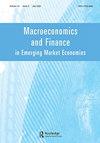Speed of adjustment and optimal leverage: evidencethe from South Asian family firms
IF 1.1
Q3 ECONOMICS
Macroeconomics and Finance in Emerging Market Economies
Pub Date : 2023-09-12
DOI:10.1080/17520843.2023.2256116
引用次数: 0
Abstract
This study examines how family firms adjust their leverage towards optimal leverage. We use the dynamic system generalized method of moments (GMM) for analysis. The findings reveal that South Asian family firms adjust about 24% towards target leverage using market leverage and about 28% while using book leverage. The findings further suggest that growth opportunities, GDP growth rate, distance, lending rate, term spread, and short-term interest rate increase the speed of adjustment towards the target leverage. On the contrary, profitability and differential between the T-bills rate and the bank rate decrease the speed of adjustment.调整速度与最优杠杆:来自南亚家族企业的证据
本研究探讨家族企业如何调整杠杆以达到最优杠杆。采用动力系统广义矩量法(GMM)进行分析。研究结果显示,南亚家族企业使用市场杠杆向目标杠杆调整约24%,使用账面杠杆调整约28%。研究结果进一步表明,增长机会、GDP增长率、距离、贷款利率、期限价差和短期利率提高了向目标杠杆调整的速度。相反,收益率和国库券利率与银行利率的差异降低了调整的速度。
本文章由计算机程序翻译,如有差异,请以英文原文为准。
求助全文
约1分钟内获得全文
求助全文
来源期刊
CiteScore
2.40
自引率
7.70%
发文量
23

 求助内容:
求助内容: 应助结果提醒方式:
应助结果提醒方式:


